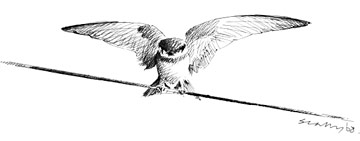Sand Martin (Riparia riparia)

Sand Martin © Ray Scally
Sand Martins live up to their scientific name and are much more likely to be near water than the other hirundines. Sand Martins live in colonies containing anything from a few to several hundred pairs, and make their nests by burrowing into vertical faces. The association with water, for feeding and for nesting, is dramatically illustrated by the habitat codes submitted for this survey. 80% of the Sand Martin records were in class G – freshwater – compared to 3% for Swallow and House Martin. Most of the remainder were for the farmland surrounding a nesting area. The Atlas map clearly shows the lines of the county’s major rivers, especially the Dee, Dane and Bollin, plus the Manchester Ship Canal.
Most of the county’s Sand Martins, however, are to be found in the main industrial sand extraction sites, where their fortunes often depend on economic or commercial decisions of the quarry operators. The amount of construction sand being quarried, mostly in the Delamere/ Sandiway area, largely follows the major building projects and is now only half of the peak in the mid-1990s, and there are fewer exposed sand-faces, many of them being sloping rather than vertical. There are more likely to be suitable breeding sites in the Chelford and Congleton quarries, extracting the whiter, sharper silica sand; there is less fluctuation in its use, for making glass, moulds for foundries and ceramic glazes, and nearly half of the UK’s nationally important reserves are in the glacial deposits of east Cheshire.
Their distribution appears to have contracted compared to the First Atlas, with 47 tetrads with confirmed or probable breeding compared to 82 then (B and N regarded as confirmed breeding in First Atlas), but with such a peripatetic species, a 3-year survey will inevitably find fewer occupied sites than one spanning 7 years. Such a colonial species cannot be reliably monitored by the normal BBS methods, but counts of apparently occupied nest-holes provide a good census. Based on annual surveys of the mid-Cheshire quarries, the Cheshire breeding population in an average year is estimated at 1,500 pairs. Their population can swing markedly from one year to another, mainly driven by the winter mortality (Cowley & Siriwardena 2005). They migrate to spend the winter in West Africa just south of the Sahara: Cheshire-ringed birds have been reported from the Niger inundation zone in Mali and the Djoudj National Park in northern Senegal. Year-to-year ringing in the mid-Cheshire quarries shows that the annual survival of adult Sand Martins varies from 12% in the worst year (1983-84) to around 50% in the best years, determined almost entirely by the rainfall prior to their arrival in west Africa (Norman & Peach to be published). In the drier years there are too few flying insects to support the population, so many birds starve, and they are at increased risk of other hazards such as sandstorms.
This is one of our earliest spring migrants, with the first birds in March, but the main arrival in April is only patchily recorded. In years with cold, wet springs, many birds gather at the county’s meres and reservoirs to feed. In dry and warm weather, best for the birds, most of them make their way straight to breeding sites, so birdwatchers at migration points and waterbodies see few Sand Martins and declare it to be ‘a poor spring’ for the species. Nests can be constructed in a few days, with chicks flying by the end of May in some years. Many pairs will have a second brood, often shifting to a new site, partly to avoid nest collapse as the sand dries out, and to minimise infection by nest parasites such as ticks. The first-broods are best for the species because juveniles fledging early in the season survive the immediate post-fledging period better (Cowley 2001).
As well as avalanches, which can cause total loss of a colony, their other main hazards are land-based predators, especially foxes, badgers and mink, who dig out the nests and contents. Raptors take some flying birds, Hobbies being especially feared. In the 1990s, as breeding Hobbies started to move into the county, it was interesting to observe that Sand Martins scattered in fright at their special ‘Hobby’ alarm call, different from that given for other aerial predators, even though they had never previously experienced such attacks at Cheshire colonies.
Sponsored by Syngenta CTL

